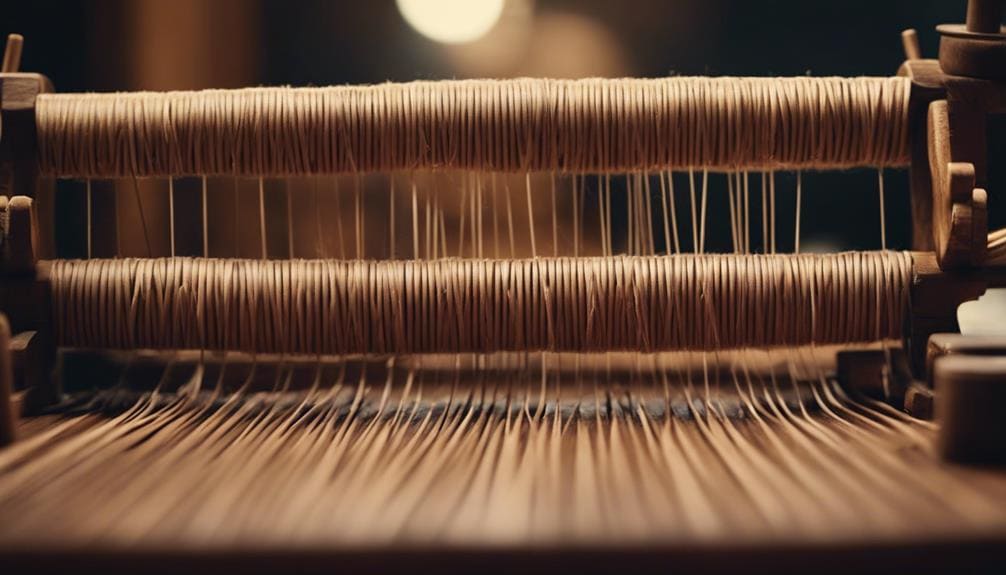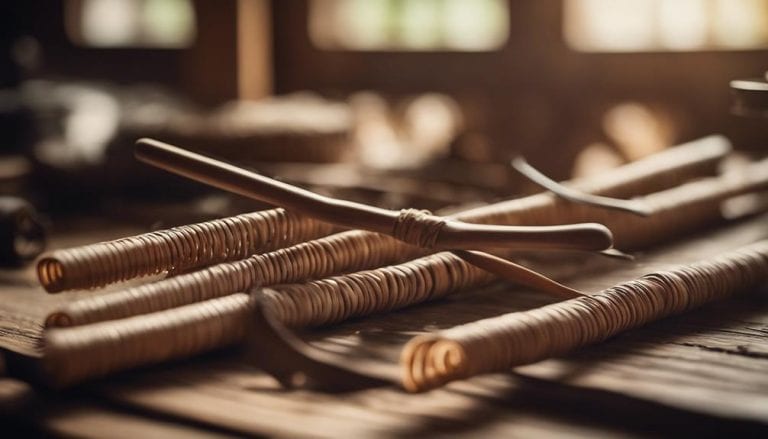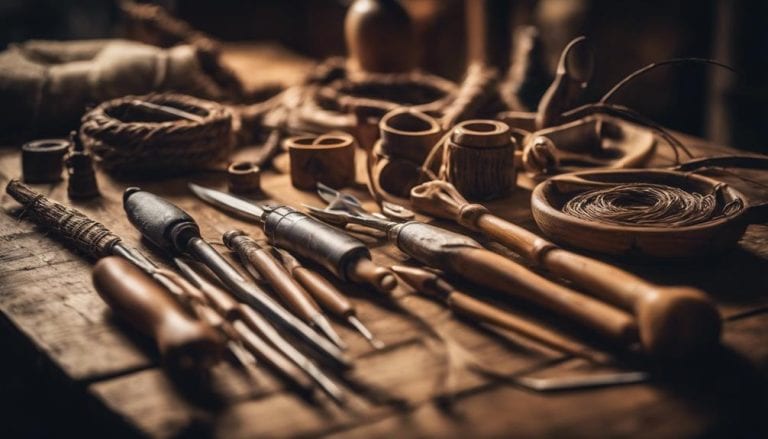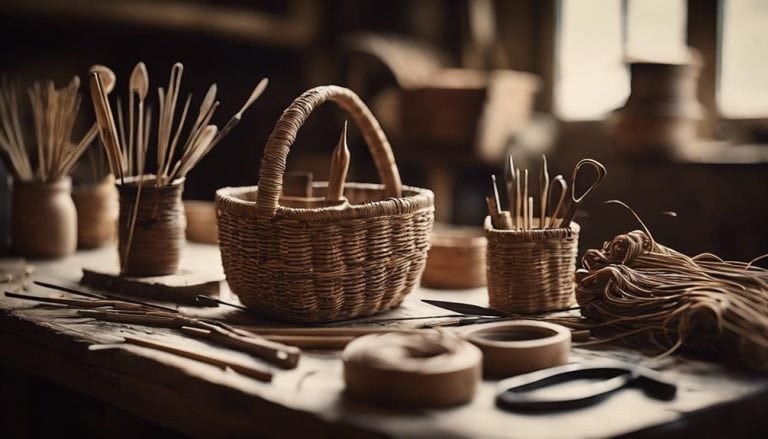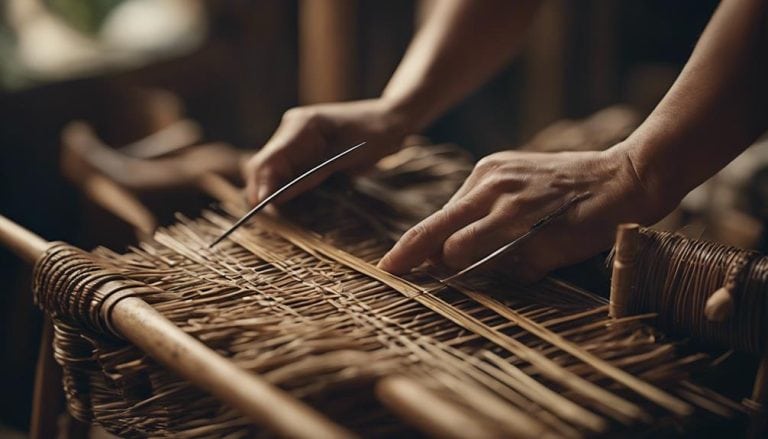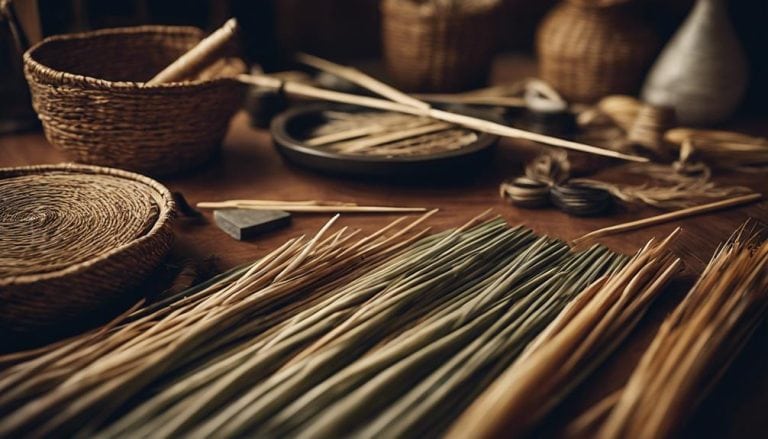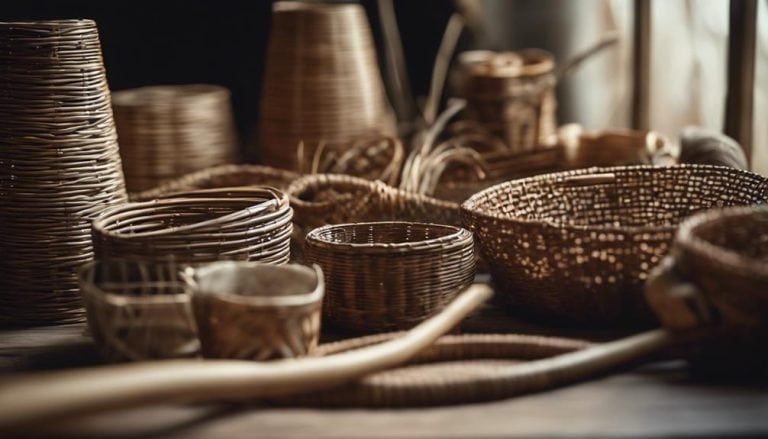Equipment for Traditional Rattan Weaving
When immersing myself in the intricate art of traditional rattan weaving, I can’t help but marvel at the array of specialized tools and materials essential for this craft. From the rhythmic slicing of reeds to the deft manipulation of weaving frames, each item is crucial in bringing forth masterful creations. As the dialogue unfolds, we will unravel the significance of these tools and delve into the intricate world of rattan weaving, where skill meets creativity in perfect harmony.
Essential equipment for traditional rattan weaving includes a weaving frame and sharp cutting tools. These tools are crucial for crafting intricate rattan patterns with precision and efficiency.
Key Takeaways
- Essential hand tools like knives and chisels are crucial for intricate designs.
- Specialized weaving frames ensure stability and tension maintenance for quality weaving.
- Quality rattan cane from Southeast Asia is vital for durability and flexibility.
- Eco-friendly practices like sourcing sustainable materials contribute to environmental conservation.
Essential Hand Tools
When crafting traditional rattan pieces, knives, gouges, chisels, and awls are essential for achieving intricate designs and precise cuts. The ergonomic handles of these tools fit comfortably in my hand, allowing me to work with ease and grace. The precision blades enable me to shape the rattan strands accurately, bringing to life the intricate patterns passed down through generations.
Skill development in using these tools is a journey of patience and practice, honing my ability to create masterfully woven artworks. Proper tool maintenance is crucial to ensure the longevity of these implements, preserving their sharpness and effectiveness in shaping the rattan fibers. As I immerse myself in traditional rattan weaving, these essential hand tools become an extension of my hands, guiding me in the intricate dance of craft and creativity.
Specialized Weaving Frames
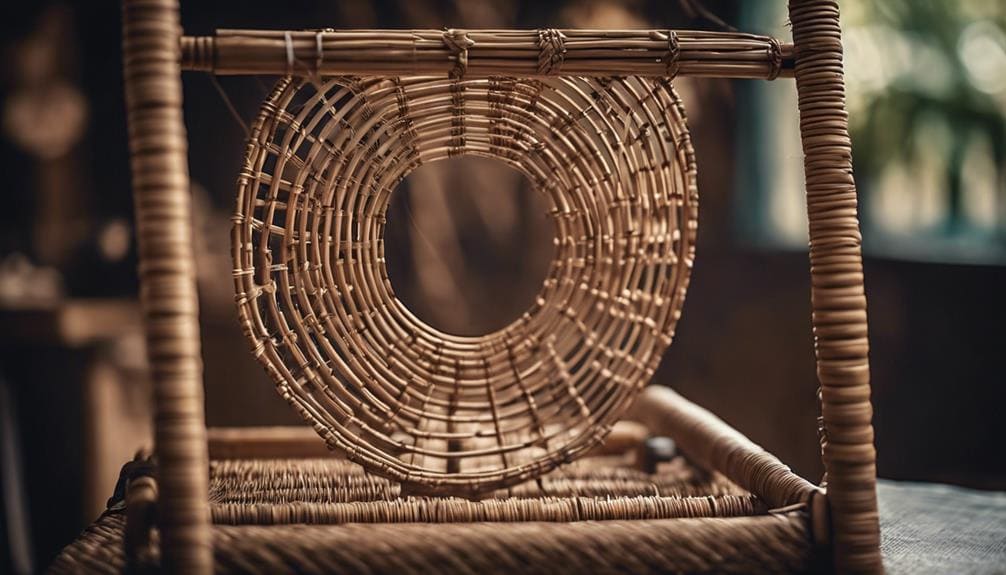
Crafting traditional rattan pieces involves utilizing specialized weaving frames, which provide a stable structure essential for maintaining the tension of the rattan strands and ensuring consistent results in intricate weaving projects. These frames are vital in the rattan weaving process, offering the necessary support and stability for creating pieces that showcase intricate patterns and designs.
Here are some key aspects to consider about specialized weaving frames:
- Frame Stability: The frames are designed to withstand the tension of the rattan strands, ensuring that the weaving process progresses smoothly without compromising the structure of the final piece.
- Intricate Patterns: These frames allow weavers to easily achieve complex and detailed patterns easily, enhancing traditional rattan pieces’ beauty and cultural significance.
- Consistent Results: Specialized weaving frames contribute to the professional finish of the woven rattan items, guaranteeing that each piece meets the high standards expected in traditional craftsmanship.
Quality Rattan Materials
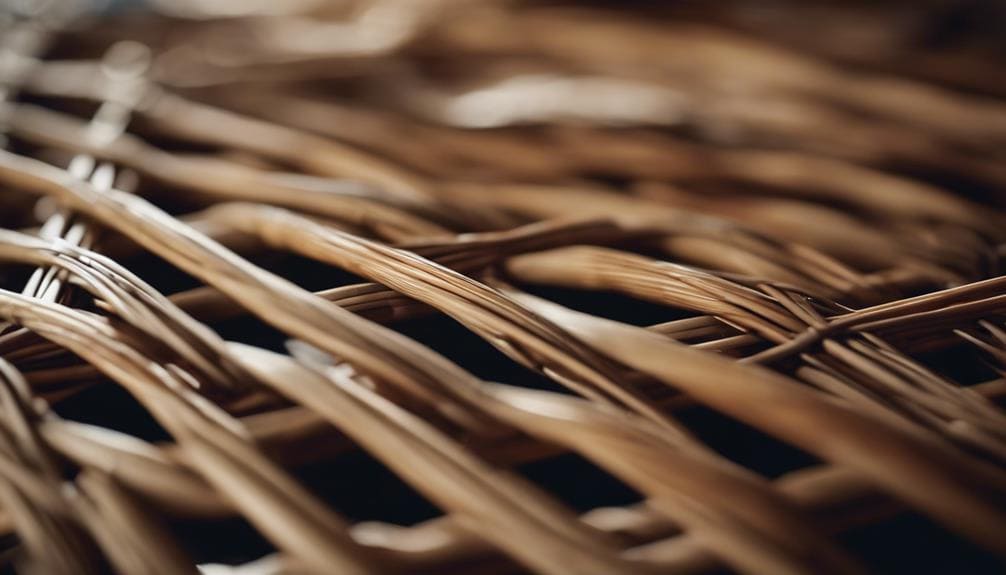
Quality rattan materials, sourced mainly from Southeast Asia, are revered for their exceptional durability and flexibility in traditional weaving practices. Rattan sourcing involves carefully selecting strips based on thickness, strength, and color consistency, ensuring optimal quality for weaving projects.
Skilled artisans favor high-grade rattan for its ability to withstand intricate weaving techniques, resulting in long-lasting and exquisite creations. The diverse natural colors of rattan, ranging from pale yellows to deep browns, inspire a kaleidoscope of weaving patterns, adding depth and richness to traditional designs.
The unique variations in rattan fibers contribute to the character and texture of the final woven pieces, making each creation a one-of-a-kind masterpiece. By utilizing properly processed and treated rattan materials, we ensure the longevity and beauty of our traditional woven products, preserving the heritage and artistry of rattan weaving for generations to come.
| Rattan Sourcing | Weaving Techniques |
|---|---|
| Southeast Asia | Intricate designs |
| Color consistency | Durability |
| Natural variations | Flexibility |
Efficient Reed Cutters
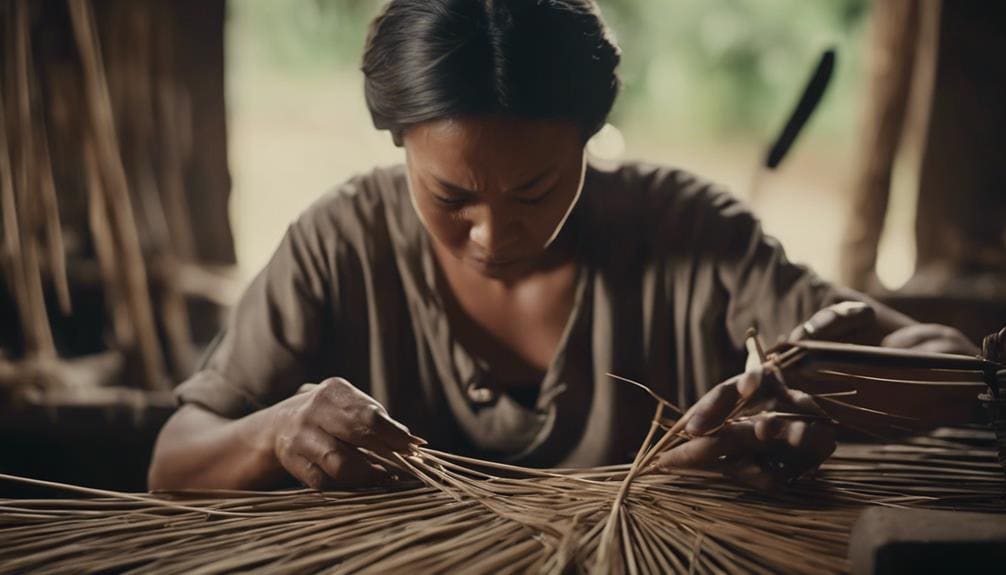
The precision of our rattan weaving work hinges on the efficiency of our reed cutters, integral tools for ensuring clean and accurate cuts in our traditional craft. With their cutting precision and blade adjustment capabilities, these cutters play a crucial role in shaping the reeds for our intricate weaves.
- Reed Versatility: Our efficient reed cutters are designed to handle various reed widths and thicknesses, allowing us to effortlessly work on different weaving projects.
- Smooth Cuts: Quality reed cutters ensure smooth and straight cuts, enhancing the weaving process by creating seamless transitions between reeds. This results in a visually appealing final product.
- Customizable Blades: The adjustable blades on reed cutters allow us to customize our cutting techniques based on the requirements of each weaving project. This ensures that every cut is made with accuracy and finesse, reflecting the essence of our traditional rattan weaving heritage.
Reliable Awls and Shears
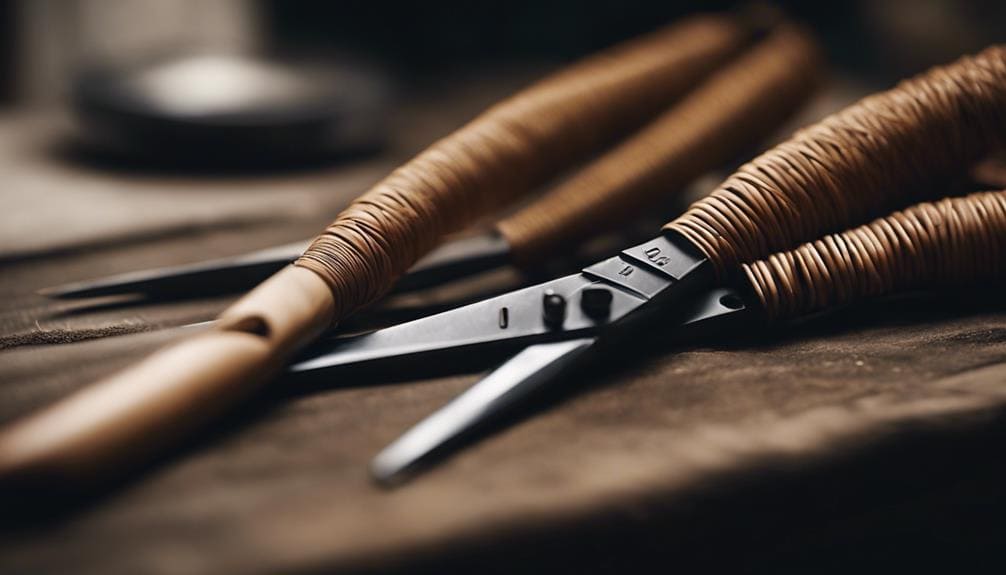
Awls and shears, essential tools in traditional rattan weaving, skillfully guide and precisely shape the intricate patterns of cane. These precision tools are vital in the crafting techniques of rattan weaving, piercing holes with accuracy and cleanly guiding the cane to create stunning designs.
High-quality awls ensure that holes are made without damaging the delicate rattan material, preserving its integrity throughout the weaving process. Similarly, sharp shears are crucial in cutting and trimming rattan strips to the desired length, allowing weavers to work efficiently and achieve smooth, uniform cuts essential for intricate patterns.
Investing in reliable awls and shears is paramount for achieving professional results in traditional rattan weaving projects. These tools enhance the final product’s quality and contribute to the crafting process’s overall efficiency and precision. Using top-notch awls and shears, we can elevate our weaving skills and create masterful pieces that reflect rattan craftsmanship’s true beauty and artistry.
Traditional Soaking Baskets
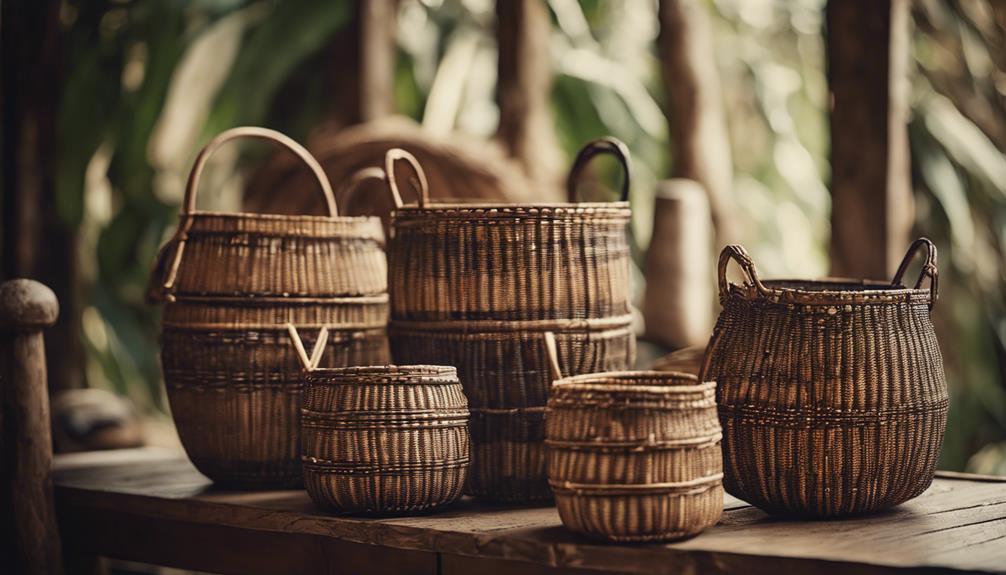
Guiding the rattan weaving process from preparation to completion, traditional soaking baskets made from sustainable materials like rattan or bamboo serve as essential vessels for softening cane or rattan strips before intricate patterns take shape. These baskets, crafted with artisan craftsmanship, embody the rich tradition of rattan weaving and are integral to the art’s essence.
- Purposeful Design: Traditional soaking baskets are meticulously constructed from sustainable rattan or bamboo, reflecting a deep respect for nature’s gifts.
- Generous Capacity: These baskets boast ample space to accommodate a significant quantity of cane or rattan strips, allowing for thorough soaking and softening.
- Enhancing Flexibility: Through the soaking process facilitated by these baskets, the cane or rattan strips become pliable and easier to manipulate, setting the stage for weaving mastery.
Embracing traditional soaking baskets not only honors the heritage of rattan weaving but also ensures that the craft continues to thrive sustainably for generations to come.
Secure Binding Materials
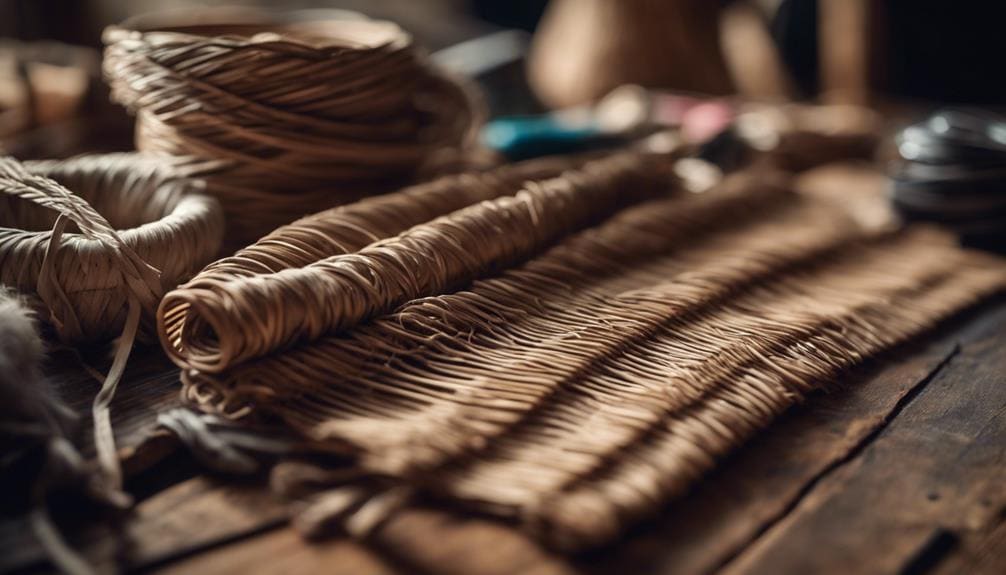
Integrating durable binding materials such as waxed linen thread or synthetic sinew is essential in traditional rattan weaving to ensure the strength and longevity of the final woven pieces. When selecting binding materials, consider alternative options like eco-friendly waxed linen thread or synthetic sinew for modern adaptations. These materials not only offer innovative techniques but also provide strong binding capabilities required for intricate weaving patterns.
Waxed linen thread, known for its strength and resistance to wear, has been a staple in traditional rattan weaving for generations. Synthetic sinew, on the other hand, offers a sustainable alternative to natural materials, ensuring that the rattan strands are tightly secured together during weaving.
By choosing the right binding materials, we uphold the cultural heritage of rattan weaving while embracing eco-friendly and modern approaches in our craft. Let us weave together tradition and innovation, creating pieces that stand the test of time.
Frequently Asked Questions
What Are the Tools Used by Basket Weavers?
I shape nature’s gifts into art with tools like knives, gauges, and chisels. My skilled hands bring rattan stripping and basket patterns to life. Every cut is deliberate, and every weave tells a story.
How Do You Prepare Rattan for Weaving?
To prepare rattan for weaving, I soak it in water to make it pliable. After cleaning and drying, I cut it into lengths for traditional patterns. Soaking duration varies, impacting weaving techniques. Consistency in size ensures smooth weaving.
What Is Needed for Basket Weaving?
I gather various materials, such as reed and rattan, for basket weaving. I enjoy creating intricate designs with these natural elements. The process allows me to explore creativity and connects me to traditions and nature.
How Long to Soak Rattan Before Weaving?
When weaving rattan, soaking it for 12 hours enhances flexibility and prevents breakage. Extending soaking to 24-48 hours improves pliability. Thicker rattan may need 2-3 days. Soaking prevents splitting and ensures smooth weaving and durability.
Conclusion
As a traditional rattan weaver, I have found that investing in high-quality equipment is essential for creating intricate and durable woven pieces. For example, using specialized weaving frames and reliable awls has allowed me to craft unique designs that showcase the beauty of rattan materials. By utilizing traditional soaking baskets and efficient reed cutters, I have produced functional and aesthetically pleasing products that honor the rich cultural heritage of rattan weaving.

